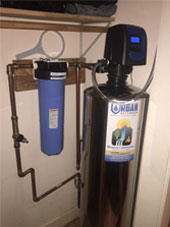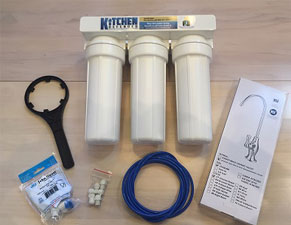Chlorinated Water and Cancer
Trihalomethanes Induce Colorectal Cancers
The National Toxicology Program reported that trihalomethanes, which are by-products of water chlorination, induce colorectal cancers in rats (3). Epidemiological studies also suggest an association between consumption of chlorination by-products in drinking water and an increased risk for colorectal cancer in humans (4). Although disinfection of drinking water by chlorination has been a major disease prevention treatment, these findings raise an important public health concern because of the large number of people who consume chlorinated water. In recent years there has been extensive study of the molecular events involved in the development of human colorectal cancer. Consequently, the molecular genetics of colorectal carcinoma are among the best understood of any common human cancer.
Of the 435 chemicals studied for their carcinogenic potential in long-term rodent studies by the NCI/NTP, 14 showed evidence of colorectal carcinogenicity in rats. Two of these chemicals that caused marked increases in tumor incidence were the brominated trihalomethanes, bromoform, and bromodichloromethane. Three other brominated chemicals caused a colon cancer response that was greater than 10%. Oral exposure to bromodichloromethane caused adenomas or adenocarcinomas in greater than 90% of the high dose male rats. This is a dramatic chemical effect because colorectal cancers are uncommon in untreated rats, occurring at a rate of approximately 0.1%.
The morphological characteristics of the colorectal epithelial tumors induced by the trihalomethanes are similar to those observed in human colorectal cancers. Nodules observed grossly on the mucosal surface were frequently multiple. Microscopically there was a spectrum of lesions present in the distal colon and rectum; the earliest precursor lesion was focal atypical hyperplasia (corresponding to dysplasia) with a high mitotic index. These lesions progressed to adenomas and carcinomas exhibiting invasion into the muscularis mucosa. No metastases were observed in this study, and the tumor response was greater in males than in females.
A meta-analysis of data from nine published case-control and cohort studies that examined associations between chlorinated drinking water and colon cancer, colorectal cancer, or rectal cancer was presented. By definition, the exposed groups in this analysis had higher exposure to chlorination by-products than the unexposed groups based on their use of either surface water (versus groundwater) or chlorinated water (versus unchlorinated or chloraminated water). Relative risk estimates for all sites included in these studies were compiled by pooling the study results. Although all of the sites had relative risks greater than one, significant increases were obtained only for bladder cancer and for rectal cancer. For those studies that gave some estimate of exposure, dose responses for colon and rectal cancer were evident when the exposure subgroups were categorized as low, moderate, and high. Other drinking water contaminants, besides the trihalomethanes, may have contributed also to the increased risks of rectal cancer.
An epidemiological study of drinking water in Iowa residents demonstrated an association between consumption of chlorination by-products from chlorinated surface water sources and increased risk for rectal cancer, but not for bladder cancer or colon cancer. Rectal cancer risk associated with chlorination by-products appeared to be influenced by lifestyle factors (e.g., physical activity).
Conclusions and Future Needs
A general discussion following the presentations arrived at the following conclusions:
Both epidemiological data and animal data indicate that trihalomethanes pose a potential carcinogenic risk to humans. The animal studies are considered to be particularly predictive of potential human risk because of the site correspondence in tumor response, the fact that colon and rectal cancers are uncommon in rodents, and because morphological features of the tumors induced in animals are analogous to those observed in human colorectal tumors. The Min mouse, which possesses an APC mutation, is a useful model to study the influence of environmental factors on familial adenomatous polyposis. Because the brominated chemicals are more active than chlorinated chemicals in the animal models and because the brominated trihalomethanes are formed as a result of bromide ions in the source water, epidemiological studies of colorectal cancer in regions with high bromide content in the source water (e.g., coastal regions) would yield greater insight on risks associated with exposure to trihalomethanes.
The distinction between rectal cancer versus colon cancer in many cases is a difficult one. There are no studies available comparing the molecular genetics of tumors at these two sites. Differences in p53 or ras gene mutation rates in the proximal versus distal colon suggest that a gradient of response rather than absolute distinctions may exist. Currently it is reasonable to consider colon and rectal cancers in animals as arising by a similar process.
Epidemiological studies of by-products of water chlorination need better characterization of exposure and greater consideration of other risk factors. Studies of occupational cohorts exposed to trihalomethanes or other brominated chemicals may also shed light on the relationship between these chemicals in drinking water and cancer risk.
To better understand the mechanisms of cancer induction by trihalomethanes, we need to know what enzymes are involved in the activation of these chemicals and in particular the relative roles of the cytochrome P450 isozymes and glutathione-S-transferase. The types and frequencies of mutations induced by these chemicals in critical target genes in colorectal tumors in animal models need to be characterized. There is no evidence at present for a nonmutagenic mechanism in trihalomethane-induced colorectal cancer.
Polymorphisms that are involved in either the activation of the chemical (e.g., glutathione-S-transferase and cytochrome P4502E1), the deactivation of mutagenic intermediates, or the control of the disease process (e.g., oncogenes and tumor-suppressor genes) can influence the cancer risk associated with exposure to environmental carcinogens. In addition, the degree of induction of inducible metabolic enzymes can show substantial interindividual variability and environmental factors may influence the expression of various genetic susceptibilities. Thus, genetically susceptible subpopulations should be identified and analyzed separately for their cancer risk.
References
1. Miller BA, Ries LAG, Hankey BF, Kosary CL, Edwards BK, eds. Cancer statistics review: 1973-1989. NIH Publication no. 92-2789. Bethesda, MD:National Cancer Institute, 1992.
2. Aaltonen LA, Peltomaki P, Leach FS, Sistonen P, Pylkkanen L, Mecklin JP, Jarvinen H, Powell SM, Jen J, Hamilton SR, Petersen GM, Kinzler KW, Vogelstein B, de la Chapelle A. Clues to the pathogenesis of familial colorectal cancer. Science 260:812-816 (1993).
3. Dunnick JK, Melnick RL. Assessment of the carcinogenic potential of chlorinated water: experimental studies of chlorine, chloramine, and trihalomethanes. J Natl Cancer Inst 85:817-822 (1993).
4. Morris RD, Audet AM, Angelillo IF, Chalmers TC, Mosteller F. Chlorination, chlorination by-products, and cancer: a meta-analysis. Am J Public Health 82:955-963 (1992).
Last Update: July 30, 1998
***
Return to the Resource Library

James P McMahonEcologist
"What's in YOUR Water?"
 ©
©
Sweetwater, LLC
Return to:
Home Water Purification Systems
* * *
Home Water Purification Systems Air Purification Consultations Buy my Ultimate Guide Resource Library
Water Purifiers Arsenic Iron Removal Commercial Healing Waters Rainwater
Whole House Water Purification Water Testing Healthy Links Biography Well Water Rave Reviews








